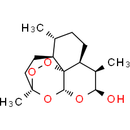Description
Dihydroartemisinin is a potent anti-malaria agent.
Product information
CAS Number: 71939-50-9
Molecular Weight: 284.35
Formula: C15H24O5
Synonym:
Dihydroqinghaosu; β-Dihydroartemisinin
Artenimol
Chemical Name: (1R, 4S, 5R, 8S, 9R, 10S, 12R, 13R)-1, 5, 9-trimethyl-11, 14, 15, 16-tetraoxatetracyclo[10.3.1.0, .0, ]hexadecan-10-ol
Smiles: C[C@@]12CC[C@H]3[C@H](C)CC[C@H]4[C@@H](C)[C@@H](O)O[C@H](O1)[C@]43OO2
InChiKey: BJDCWCLMFKKGEE-ISOSDAIHSA-N
InChi: InChI=1S/C15H24O5/c1-8-4-5-11-9(2)12(16)17-13-15(11)10(8)6-7-14(3,18-13)19-20-15/h8-13,16H,4-7H2,1-3H3/t8-,9-,10+,11+,12+,13-,14-,15-/m1/s1
Technical Data
Appearance: Solid Power
Purity: ≥98% (or refer to the Certificate of Analysis)
Solubility: DMSO : 41.67 mg/mL (146.54 mM; Need ultrasonic)
Shipping Condition: Shipped under ambient temperature as non-hazardous chemical or refer to Certificate of Analysis
Storage Condition: Dry, dark and -20 oC for 1 year or refer to the Certificate of Analysis.
Shelf Life: ≥360 days if stored properly.
Stock Solution Storage: 0 - 4 oC for 1 month or refer to the Certificate of Analysis.
Drug Formulation: To be determined
HS Tariff Code: 382200
How to use
In Vitro:
Dihydroartemisinin (DHA) is an antimalarial agent. Dihydroartemisinin treatment effectively up-regulates the cytosolic RelA/p65 protein level and down-regulates the nuclear RelA/p65 protein level. Dihydroartemisinin blocks the nuclear translocation of RelA/p65 from the cytosol rather than suppressing RelA/p65 protein synthesis. Dihydroartemisinin induces autophagy in RPMI 8226 cells. Dihydroartemisinin suppresses NF-κB activation in RPMI 8226 cells. The NF-κB Dihydroartemisinin -binding activity is examined by EMSA assay. RPMI 8226 cells are exposed to various concentrations of Dihydroartemisinin (10, 20 and 40 μM) for 12 h, and TNF-α is introduced as a positive control for NF-κB activation. Dihydroartemisinin suppresses NF-κB activation in a dose-dependent manner in contrast with TNF-α. Dihydroartemisinin (DHA) can enhance the anti-tumor effect of photodynamic therapy (PDT) on esophageal cancer cells, and cell viability is investigated using the MTT assay. Eca109 and Ec9706 cells are treated with Dihydroartemisinin (80 μM), PDT (25 and 20 J/cm2, respectively) or their combination. Single treatment with Dihydroartemisinin or PDT causes a 37±5% or 34±6% reduction in viability in Eca109 cells and a 33±7% or 34±6% reduction in Ec9706 cells, respectively. However, when PDT is combined with Dihydroartemisinin, the cell viability is reduced 59±6% or 61±7% in the cell lines, respectively.
In Vivo:
Single oral doses of Dihydroartemisinin (at 200, 300, 400 or 600 mg/kg), given once on each of day 6-8 post-infection, reduce total-worm burdens by 69.2%-90.6% and female-worm burdens by 62.2%-92.2%, depending on dosage in the first experiment. Similar treatments given on day 34-36 post-infection reduce total-worm burdens by 73.9%-85.5% and female-worm burdens by 83.8%-95.3%.
References:
- Hu W, et al. Dihydroartemisinin induces autophagy by suppressing NF-κB activation. Cancer Lett. 2014 Feb 28;343(2):239-48.
- Li HJ, et al. Dihydroartemisinin-praziquantel combinations and multiple doses of dihydroartemisinin in the treatment of Schistosoma japonicum in experimentally infected mice. Ann Trop Med Parasitol. 2011 Jun;105(4):329-33.
- Li YJ, et al. Dihydroartemisinin accentuates the anti-tumor effects of photodynamic therapy via inactivation of NF-κB in Eca109 and Ec9706 esophageal cancer cells. Cell Physiol Biochem. 2014;33(5):1527-36.
Products are for research use only. Not for human use.
Payment & Security
Your payment information is processed securely. We do not store credit card details nor have access to your credit card information.


